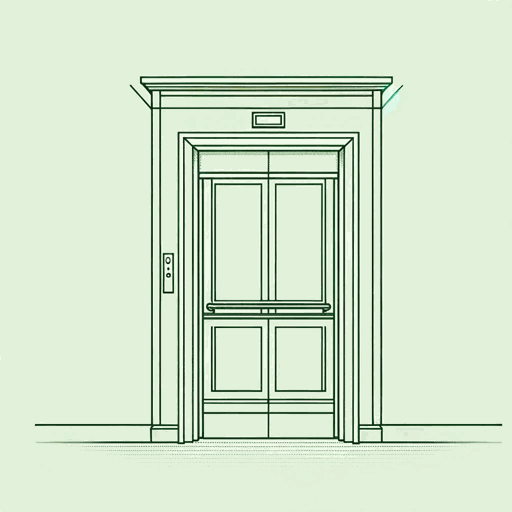44 pages • 1 hour read
Colson WhiteheadThe Intuitionist
Fiction | Novel | Adult | Published in 1999A modern alternative to SparkNotes and CliffsNotes, SuperSummary offers high-quality Study Guides with detailed chapter summaries and analysis of major themes, characters, and more.
Summary and Study Guide
Overview
The Intuitionist (1999) is a postmodern novel by American author Colson Whitehead. It is set in an unnamed city that resembles New York in the 1940s, but with one major difference: in this city, elevators (or “vertical transport”) have enormous political and economic clout. The City’s Department of Elevator Inspectors is collapsing into a corrupt power-struggle between “Empiricist” inspectors, who perform mechanical testing to establish the safety of an elevator, and the new breed of “Intuitionist” inspectors, who intuitively feel the safety of an elevator. The novel follows an Intuitionist inspector, Lila Mae Watson—the first “colored” woman to be employed by the Department—as she is drawn into this power struggle. The Intuitionist, hailed upon publication as a “dizzyingly-high-concept debut of genuine originality” (Kirkus Reviews), helped to establish Whitehead’s reputation as one of America’s most exciting living novelists.
As the novel opens, Lila Mae learns that there has been a serious elevator accident—a “freefall”—at the Fanny Briggs Memorial Building, which is one of “her” buildings. Until now, Lila Mae has had a perfect safety record as an elevator inspector.
She meets her friend Chuck Gould at O’Connor’s, the bar frequented by inspectors (although not by Lila Mae). Chuck explains that Frank Chancre, the Chair of the Elevator Guild and city-wide chief of elevator inspectors, is publicly blaming Lila Mae for the accident.
Not only that: The Empiricist Chancre is using the accident as an opportunity to call into question the validity of Intuitionism as an inspection philosophy. It’s a sensitive time in Elevator Guild politics. Intuitionism is a relative newcomer on the scene, but it has made big strides, in part because Intuitionist inspection is as much as 10 percent more reliable than the Empiricist approach. Chancre is running for re-election, and for the first time, he faces defeat to an Intuitionist named Orville Lever.
When Lila Mae returns home, she finds two thugs searching her apartment. The men introduce themselves as Jim Corrigan and John Murphy. Another man enters and introduces himself as Mr. Reed, Orville Lever’s campaign manager. He orders the thugs to leave.
Reed takes Lila Mae to the Intuitionist House, headquarters of the Intuitionist movement. There, he explains to her that Intuitionism’s founder, the visionary James Fulton, designed a perfect elevator, known as the “black box,” shortly before his death. It had been thought lost, but recently its blueprint has been sent to Lever and Chancre and to Lift magazine, the journal of elevator inspectors. The blueprint is incomplete, and the two factions are racing to unearth Fulton’s final notebooks. Lila Mae also gets to know Natchez, the temporary housekeeper at the Intuitionist House.
The novel’s point of view switches to Ben Urich, a Lift journalist. He has just learned that his recent article about the black box has been pulled from the magazine prior to publication. Shortly afterward, Jim and John abduct and torture him.
Meanwhile, Lila Mae is dispatched to interview Fulton’s housekeeper, Marie Claire Rogers. The Intuitionists believe Mrs. Rogers knows the whereabouts of the black box notebooks. As she leaves, Lila Mae is abducted and taken to a location the reader recognizes: it is the same place Urich was taken to. There, Lila Mae meets Chancre, who orders her to stop searching for the notebooks.
Lila Mae returns to her apartment. It has been ransacked. Natchez reveals that Mr. Reed is responsible. He also confesses that he is the nephew of James Fulton, who was a black man “passing” as white. Lila Mae and Natchez decide to team up and keep searching for the black box notebooks.
Lila Mae disguises herself as a caterer to attend the elevator inspectors’ gala celebration, the Funicular Follies. Natchez sabotages Chancre’s attempt to demonstrate a reliably safe elevator, while Lila Mae spies on her colleague Pompey—the city’s only other black inspector—whom she suspects of sabotaging the elevator at the Fanny Briggs Building. After the gala, Lila Mae confronts Pompey with her evidence. He denies responsibility for the accident but admits to taking bribes from the Mob, with Chancre’s encouragement.
Lila Mae sneaks into the Lift offices. There she encounters Urich, who shows her the blueprint for the black box. Urich explains that the two major elevator manufacturers—Arbo and United—are fighting over the plans. Jim and John work for Arbo. Looking at the evidence Urich has assembled, Lila Mae realizes that Natchez, too, is a spy for Arbo.
At the Fanny Briggs building, Lila Mae intuits that the elevator accident really was an accident. She visits Mrs. Rogers again, finding her house ransacked. Mrs. Rogers reveals that Fulton was indeed black. She also explains that Fulton had intended Intuitionism as a joke and had been mortified when the elevator inspection community took it seriously. Fulton himself had left instructions that his blueprints be sent to the major elevator companies. Mrs. Rogers hands over Fulton’s final journals, containing the final information needed to build the black box.
Lila Mae goes to the Arbo offices and hands over the journals to Natchez (real name Raymond Coombs).
The novel jumps forward in time. Lila Mae is living in a nice new apartment and working on the third volume of Fulton’s treatise Theoretical Elevators (extracts from which are interspersed throughout the book). The notebook in Arbo’s possession contains only fragments, useless to elevator manufacturers. Only Lila Mae knows how to construct the perfect elevator.
As the novel opens, Lila Mae learns that there has been a serious elevator accident—a “freefall”—at the Fanny Briggs Memorial Building, which is one of “her” buildings. Until now, Lila Mae has had a perfect safety record as an elevator inspector.
She meets her friend Chuck Gould at O’Connor’s, the bar frequented by inspectors (although not by Lila Mae). Chuck explains that Frank Chancre, the Chair of the Elevator Guild and city-wide chief of elevator inspectors, is publicly blaming Lila Mae for the accident.
Not only that: The Empiricist Chancre is using the accident as an opportunity to call into question the validity of Intuitionism as an inspection philosophy. It’s a sensitive time in Elevator Guild politics. Intuitionism is a relative newcomer on the scene, but it has made big strides, in part because Intuitionist inspection is as much as 10 percent more reliable than the Empiricist approach. Chancre is running for re-election, and for the first time, he faces defeat to an Intuitionist named Orville Lever.
When Lila Mae returns home, she finds two thugs searching her apartment. The men introduce themselves as Jim Corrigan and John Murphy. Another man enters and introduces himself as Mr. Reed, Orville Lever’s campaign manager. He orders the thugs to leave.
Reed takes Lila Mae to the Intuitionist House, headquarters of the Intuitionist movement. There, he explains to her that Intuitionism’s founder, the visionary James Fulton, designed a perfect elevator, known as the “black box,” shortly before his death. It had been thought lost, but recently its blueprint has been sent to Lever and Chancre and to Lift magazine, the journal of elevator inspectors. The blueprint is incomplete, and the two factions are racing to unearth Fulton’s final notebooks. Lila Mae also gets to know Natchez, the temporary housekeeper at the Intuitionist House.
The novel’s point of view switches to Ben Urich, a Lift journalist. He has just learned that his recent article about the black box has been pulled from the magazine prior to publication. Shortly afterward, Jim and John abduct and torture him.
Meanwhile, Lila Mae is dispatched to interview Fulton’s housekeeper, Marie Claire Rogers. The Intuitionists believe Mrs. Rogers knows the whereabouts of the black box notebooks. As she leaves, Lila Mae is abducted and taken to a location the reader recognizes: it is the same place Urich was taken to. There, Lila Mae meets Chancre, who orders her to stop searching for the notebooks.
Lila Mae returns to her apartment. It has been ransacked. Natchez reveals that Mr. Reed is responsible. He also confesses that he is the nephew of James Fulton, who was a black man “passing” as white. Lila Mae and Natchez decide to team up and keep searching for the black box notebooks.
Lila Mae disguises herself as a caterer to attend the elevator inspectors’ gala celebration, the Funicular Follies. Natchez sabotages Chancre’s attempt to demonstrate a reliably safe elevator, while Lila Mae spies on her colleague Pompey—the city’s only other black inspector—whom she suspects of sabotaging the elevator at the Fanny Briggs Building. After the gala, Lila Mae confronts Pompey with her evidence. He denies responsibility for the accident but admits to taking bribes from the Mob, with Chancre’s encouragement.
Lila Mae sneaks into the Lift offices. There she encounters Urich, who shows her the blueprint for the black box. Urich explains that the two major elevator manufacturers—Arbo and United—are fighting over the plans. Jim and John work for Arbo. Looking at the evidence Urich has assembled, Lila Mae realizes that Natchez, too, is a spy for Arbo.
At the Fanny Briggs building, Lila Mae intuits that the elevator accident really was an accident. She visits Mrs. Rogers again, finding her house ransacked. Mrs. Rogers reveals that Fulton was indeed black. She also explains that Fulton had intended Intuitionism as a joke and had been mortified when the elevator inspection community took it seriously. Fulton himself had left instructions that his blueprints be sent to the major elevator companies. Mrs. Rogers hands over Fulton’s final journals, containing the final information needed to build the black box.
Lila Mae goes to the Arbo offices and hands over the journals to Natchez (real name Raymond Coombs).
The novel jumps forward in time. Lila Mae is living in a nice new apartment and working on the third volume of Fulton’s treatise Theoretical Elevators (extracts from which are interspersed throughout the book). The notebook in Arbo’s possession contains only fragments, useless to elevator manufacturers. Only Lila Mae knows how to construct the perfect elevator.
Related Titles
By Colson Whitehead
Study Guide

Apex Hides the Hurt
Colson Whitehead
Study Guide

Crook Manifesto
Colson Whitehead
Study Guide

Harlem Shuffle
Colson Whitehead
Plot Summary

John Henry Days
Colson Whitehead
Study Guide

Sag Harbor
Colson Whitehead
Study Guide

The Nickel Boys
Colson Whitehead
Teaching Guide + Study Guide

The Underground Railroad
Colson Whitehead
Study Guide

Zone One
Colson Whitehead

